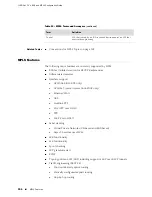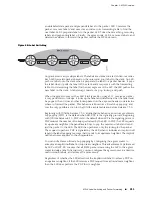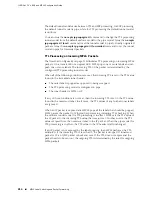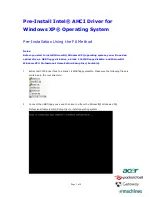
3.
The source address of ICMP packet is set to the router ID of the router on which
the TTL expired.
4.
The first 128 bytes of the MPLS packet including the IP payload encapsulated in
the MPLS packet are copied into the payload of the ICMP packet, followed by
the entire label stack of the original packet.
The ICMP packet is label-switched to the end of the LSP. From that location, the
packet is forwarded back to the source of the IP packet. This behavior enables IP
trace-route to work even when the LSR in the middle of the LSP does not have an IP
route to the source address of the IP packet.
Related Topics
■
MPLS Label Distribution Methodology on page 218
■
Mapping IP Data Packets onto MPLS LSPs on page 220
■
MPLS Forwarding and Next-Hop Tables on page 224
■
MPLS Interfaces and Interface Stacking on page 227
■
Topology-Driven LSPs on page 246
MPLS Label Distribution Methodology
The JUNOSe implementation of MPLS supports the following methods of label
distribution:
■
Downstream-on-demand, ordered control with RSVP-TE
■
Downstream-unsolicited, independent control or ordered control with LDP;
ordered control is the default. BGP accepts only downstream-unsolicited, ordered
control
Downstream-on-demand
means that MPLS devices do not signal a FEC-to-label binding
until requested to do so by an upstream device. Upstream is the direction toward a
packet’s source; the ingress node in an MPLS domain is the farthest possible upstream
node. Downstream is the direction toward a packet’s destination; the egress node
in an MPLS domain is the farthest possible downstream node. The egress node is
sometime referred to as the
tunnel endpoint
.
Downstream-on-demand conserves labels in that they are not bound until they are
needed and the LSR receives label mappings (also known as label bindings) from a
neighbor that is the next hop to a destination; it is used when RSVP is the signaling
protocol.
Ordered control
means that an LSR does not advertise a label for a FEC unless it is
the egress LSR for the FEC or until it has received a label for the FEC from its
downstream peer. In this manner the entire LSP is established before MPLS begins
to map data onto the LSP, preventing inappropriate (early) data mapping from
occurring on the first LSR in the path.
An LSR is an egress LSR for a FEC when the FEC is its directly attached interface or
when MPLS is not configured on the next-hop interface.
218
■
MPLS Label Distribution Methodology
JUNOSe 11.1.x BGP and MPLS Configuration Guide
Summary of Contents for BGP
Page 6: ...vi ...
Page 8: ...viii JUNOSe 11 1 x BGP and MPLS Configuration Guide ...
Page 37: ...Part 1 Border Gateway Protocol Configuring BGP Routing on page 3 Border Gateway Protocol 1 ...
Page 38: ...2 Border Gateway Protocol JUNOSe 11 1 x BGP and MPLS Configuration Guide ...
Page 234: ...198 Monitoring BGP JUNOSe 11 1 x BGP and MPLS Configuration Guide ...
Page 236: ...200 Multiprotocol Layer Switching JUNOSe 11 1 x BGP and MPLS Configuration Guide ...
Page 542: ...506 Monitoring BGP MPLS VPNs JUNOSe 11 1 x BGP and MPLS Configuration Guide ...
Page 544: ...508 Layer 2 Services Over MPLS JUNOSe 11 1 x BGP and MPLS Configuration Guide ...
Page 610: ...574 Virtual Private LAN Service JUNOSe 11 1 x BGP and MPLS Configuration Guide ...
Page 624: ...588 VPLS References JUNOSe 11 1 x BGP and MPLS Configuration Guide ...
Page 680: ...644 Virtual Private Wire Service JUNOSe 11 1 x BGP and MPLS Configuration Guide ...
Page 724: ...688 Monitoring MPLS Forwarding Table for VPWS JUNOSe 11 1 x BGP and MPLS Configuration Guide ...
Page 725: ...Part 6 Index Index on page 691 Index 689 ...
Page 726: ...690 Index JUNOSe 11 1 x BGP and MPLS Configuration Guide ...
















































